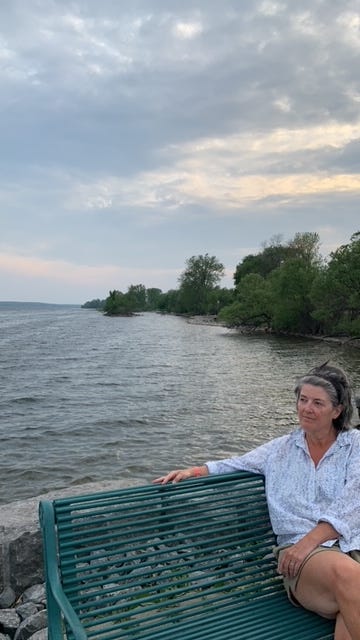Tell Me Your Ways...with Debbie Whittall
An author interview and an update on my revision journey.
In an attempt to find my own revising process, one that fits like a cozy pair of socks, but makes my book look like Hot Chick Louboutin’s, I am learning from others. In this section I'm calling "Tell me Your Ways," I'll interview my peers—from writers just starting out to best selling authors.
Debbie and I met in the most recent Shit No One Tells You About Writing 10 week Deep Dive Series (highly recommend, not only a wealth of knowledge, but you get to meet new writer buddies). She has graciously agreed to share her revision process with us.
What are you currently working on now?
I’m about two thirds of the way through a first draft of my fourth novel, women’s fiction set in the 1980s. I don’t have anything published yet but am currently querying my first novel. Writing this new one is keeping me sane while I’m greeted with form rejections – or worse, silence – during months of querying. They call it the querying trenches but for me it’s feeling more like an abyss.
Are you a plotter or a pantser? Why do you find this the best way for you to write?
I’m a bit of a plantser. I have to know how the story begins and how it ends before I can start to write. It’s telling about me as a person that I’m too afraid to start anything for which I don’t already know the ending, but need the creativity to get from A to B without a set path. That said, I’m not afraid to change the ending once I get there. I have faith that the characters will tell me what happens once I start putting their stories down on the page.
For my first novel, I wrote out one page of things I thought could/should happen on the way to the ending. My original idea for the structure didn’t work out at all, so that required a re-think. Then when the story was complete, it was only 50,000 words so there was still a lot of fleshing-out to do.
With the next three novels, including this latest one, I’m doing a rough timeline, plugging in important events. It’s helping me keep track of the plot and the timing of what needs to happen and when. What happens within the timeline is flexible. If the plot changes, I go back and change the timeline to make it fit. I wouldn’t call it plotting. But its not total pantsing either.
What does your drafting process look like?
I either write, edit or query every day. Sometimes all three.
So far, everything I’ve written includes dual timelines, and my current WIP involves overlapping timelines and dual POV. Even with that, I have to write from start to finish. I have to write one scene and then the next the same way a reader will read it, rather than writing one character or one timeline and then stitching together. I admire people who can write scenes and then move them around on post-it notes or Scrivner, but my brain just doesn’t work that way.
I don't do character outlines either, but I have a good idea of my protagonist in my head before I start to write. Once I get her down on paper the story just sort of flows from there. In my latest, I struggled a lot because one character wasn’t as developed as another. It was painstaking to find her through writing. As a result, I created a lot of words that went out the window while I got to know her motivation and stakes. I won’t make that mistake again.
I like to get on a roll and write without quotes or dialogue tags. The next day when I sit down to pick up the story, I add the punctuation and dialogue tags as a way of getting back into the story. Then I plunge ahead again without punctuation, etc.
Please walk us through a little of what your revision process looks like?
I love editing. I know that’s a little geeky, but I do. I used to work for the government so I embrace the idea that nothing is ever perfect the first time around. You can come back at any piece of writing from many angles and lenses.
I’ll read a piece through once just to smooth out rough edges and look for copy that I’ve highlighted. Yellow is my cue to research a fact or double check a name. Magenta is my cue to finesse a sentence or an image. If I wasn’t feeling it the day I wrote it, it's my way of calling out to my future self to do better.
I’m only ready to share with my core group of critique partners after this initial pass through. During this time, I’m also re-reading the manuscript to ensure I’m making use of all five senses. Every so often I’ll stop and ask: “what did that smell like?” or “What did that feel like?” I’ll do another pass using Microsoft’s word search feature looking for the word “was” and then replacing it with stronger verbs where possible. Then I’ll do another search looking for the word “look.” It’s one I over-use.
Then I’ll share with Beta readers for big picture stuff and go over it again and again to address their observations.
How do you know when your story is done?
I think it was Leonardo da Vinci who said art is never complete, only abandoned. After four years, nine drafts, one critique partner and a dozen beta readers, I was sure my first novel was complete. But then I had a developmental edit, re-wrote a good chunk of it at a writing retreat, and spent a year going over it with a new group of critique partners. Now it’s six years, 13 drafts and 30 beta readers later, and I’m querying to deafening silence. It may not be done yet.
How many beta readers do you typically have for a project? Does anyone read all the versions?
Typically, I’ll have at least 10 beta readers for a project and at least one critique group to go over it chapter by chapter. I like a mix of beta readers who are writers themselves and others who are readers. My family does not read my stuff.
No one reads all the versions except me. I wouldn’t ask a beta reader or a critique partner to read the whole thing second or third time. If I make substantial edits, I just go looking for new beta readers.
Do you have a favorite book on the craft of writing?
The first craft book I ever read was Anne Lamott’s Bird by Bird and it has stuck with me in so many ways.
Anything else you’d like to share? Where can we find you?
I’ve just accidentally joined my 8th writing group. Shhh. Don’t tell my husband. Some of these groups are loosely defined and only 4 involve critique work. (One was formed following the fabulous TSNOTYAW Deep Dive series.) I love supporting and talking to other writers, so I enjoy the critiquing process and my communities of writers. And, I especially enjoy hearing/reading/ talking about other writers’ processes.
I share my short stories on my blog, WordsbyWhittall.blogspot.com
I’m on Instagram and Facebook, including an author page on Facebook, Debra Whittall
I’m thinking of starting a Substack to explain how I accidentally joined 8 writing groups.
Update on My Revision Journey
Revising is slow. I love drafting. LOVE IT! The word count goes straight to my dopamine receptors. The progress is measurable. Plus, it’s fast. Can’t think of a name? Put an INSERT MARVELOUS NAME HERE and keep going!
Revising, on the other hand, is meticulous work. Honestly, it feels like the difference between jumping in a giant pile of fresh fall leaves (writing my first draft) and raking them (revising at any stage). But I have enjoyed detailed work in the past and I’m trying to fall in love with this process, my new normal of how I write a book.
When I was in art school, I made lithograph prints on massive limestones. In order to do this, you first have to prepare the stone. Grind it, wash it, over and over until the stone is just right and ready to be polished. Then you can make art with it. It’s an unseen process when you view the finished piece, but it greatly affects the quality of the work—much like every single part of writing a book, most of all revision. I loved preparing the stone. It was time for me to meditate on what I was going to make with this beautiful blank slab. I’m trying to bring this feeling of contemplation and possibility into my revision process.







